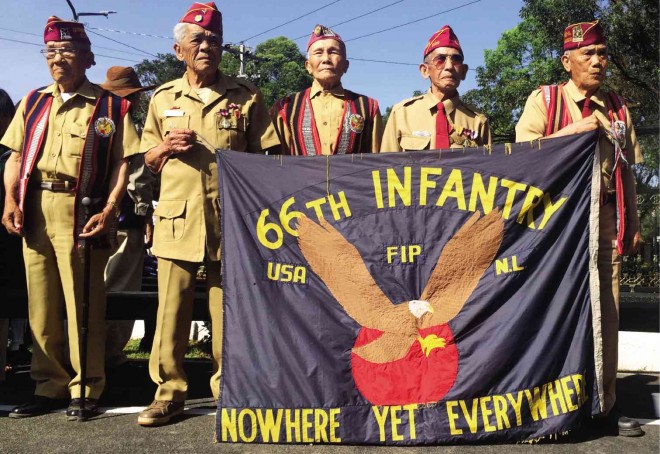Lost stories of Baguio liberators’ heroism

WAR VETERANS A few surviving members of the 66th Infantry, which helped liberate Baguio City from the Japanese Imperial Army 69 years ago, assemble for a city government celebration at Veterans Park on Sunday. VINCENT CABREZA/INQUIRER NORTHERN LUZON
BAGUIO CITY, Philippines—Igorot guerrillas helped liberate the city from Japanese occupation forces 69 years ago but a new generation of Filipinos ought to be taught once more about their heroism because it is barely reflected in current textbooks, the Philippine Military Academy (PMA) superintendent said on Sunday.
“[There have been] a lot of recollections about war heroes in books and [stories] taught in schools… but it is unfortunate that these stories of our Igorot heroes in Bataan and those who liberated Baguio on April 27, 1945, are not discussed or referenced,” Maj. Gen. Oscar Lopez said in a speech read for him by Brig. Gen. Andres Costales, PMA deputy superintendent.
PMA officials joined the city’s Liberation Day ceremonies at Baguio’s Veterans Park. A handful of war veterans came, among them surviving members of the battalion Lopez had described as “the legendary 66th Infantry.”
A fact sheet prepared by the city government said the 66th Infantry was composed of three fighting units that fought the Japanese and operated in Baguio, Benguet province and other communities in northern Luzon.
The name was the total of the numerical classification of these units: the 43rd Infantry composed of Death March survivors, the 11th Infantry, which included recruits from Itogon town in Benguet, and the 12th Infantry organized by Maj. Bado Dangwa and Maj. Dennis Molintas, who led recruits from the Benguet towns of Bokod, Kabayan, Atok and La Trinidad.
Article continues after this advertisementSome accounts say the 66th Infantry preceded the American troops who stormed Baguio, where the Japanese had been stationed, while American airplanes bombarded the city.
Article continues after this advertisement“Sadly, our own children missed out,” Lopez said, because these stories of gallantry were no longer being told in schools.
“If there is one message [that I will impart], it is about us, Filipinos, always being inspired by these brave warriors,” he said.
“The greatest honor that we can give to these patriots is to maintain the peace that many of them sacrificed their lives to attain,” Lopez said.
The Sunday event was a prelude to the 70th anniversary of Baguio’s Liberation Day in 2015. Some 600 war veterans in the Cordillera are still alive, government records showed.
Responding to the accolades, retired Vice Cmdr. Santiago Pitas of the US Armed Forces in the Far East said, “We shall return next year, hopefully.”
He sang the popular Cordillera lullaby, “Salidummay,” injecting the story of the city’s invasion. Salidummay was sung by the soldiers who fought in World War II, partly to cheer themselves up, the veterans said.
Pitas’ version stated that the Americans fled Camp John Hay, allowing the invading Japanese army to make Camp John Hay its headquarters. But Filipinos who stayed to fight won back Camp John Hay, Pitas sang. Vincent Cabreza, Inquirer Northern Luzon














